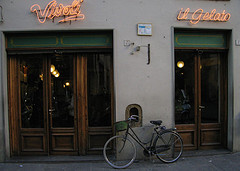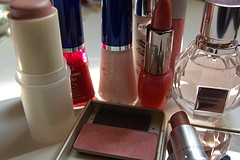25 hours after leaving Buenos Aires, Guillermo and I finally arrived at Sydney Airport. Everything went well on this long journey except the 4 hour delay in Auckland and that we had to leave behind the jars of dulce de leche we had brought with us at the Australian Customs.
We have since learnt that Argentina is not on the approved list of countries from which dairy products are allowed to be brought into Australia. Guillermo suspects that has to do with an outbreak of foot and mouth disease in Argentina some years ago.
This Australian summer has turned out to be fairly mild so far. Our Christmas Day was spent lounging on the open deck of a spectacular waterfront property. Guillermo was stunned by the breathtakingly beautiful harbour so close, it was almost touchable.
Lunch was a casual and multicultural affair in which the guests, including us, grazed on Italian style grilled vegetables, Greek dolmas, Southeast Asian satays and pot stickers while beer and wine were flowing in Aussie style abundance. We then moved indoors to a feast of turkey, ham, roasted vegetables, salads and of course, more wine.
Sweet endings were the national dessert, Pavlova, and Bill Granger's white chocolate mousse with fresh blueberries. We headed home in daylight not realising it was already close to eight in the evening.
Guillermo and I are being spoilt rotten since my parents and extended family have planned a string of diversified culinary treats for us to satisfy our pent-up desires over the past 18 months.
From the addictive aroma of Illy coffee to a proper Yum Cha with prawn dumplings and an unending array of curious delights (to a relative novice like Guillermo) being carted around the cavernous Golden Century restaurant, or the fresh clean air and serenity of suburban North Shore to the rampant consumerism at the Christmas sales, at times we feel like we have just landed on a different planet.
None more so than last night when Guillermo declared he just had the best meal in his life. We went over to my uncle's for dinner. My aunt's parents, both excellent home cooks, were originally from Sichuan which is famed for their fragrantly spicy cuisine.
We had salmon sashimi and freshly shucked oysters followed by steamed whole chicken in soy, steamed grouper fish with shallots and a number of muy picante (very spicy) vegetable dishes expertly done using a vegetable, native to Sichuan, which my aunt grows organically in her backyard in Sydney.
This pale green plant looks deceptively ordinary. The long pointy leaves are usually lightly stir fried and then dressed in sesame oil and chilli oil. The almost tuber like stalk can be eaten raw in a salad; ours last night was one of shredded carrot, shredded stalk of this green vegetable and mung bean vermicelli dressed in soy, sesame oil and chilli flakes. When lightly stir fried, it takes on a texture somewhere between cooked cucumber and Chinese summer melon.
With this much feasting, Guillermo has been true to his words; he has taken up running in our leafy neighbourhood each morning. While I'm sure he enjoys the enveloping greenery very much, I suspect his exercising is to do with making room for the amazing meals to come.
 I am a firm believer of each city revealing herself to each individual in different ways.
I am a firm believer of each city revealing herself to each individual in different ways.





 If I had a "peeves" list, the
If I had a "peeves" list, the 




















